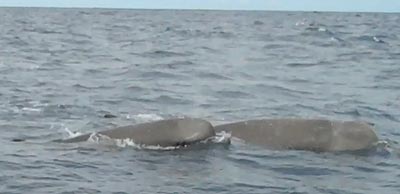 |
| Northern bottlenose whales are spotted off the bow of Balaena. |
Hunted for centuries for their oil (and until the 1970s for dog food), there may be only 160 of these gentle giants in the population found off Nova Scotia. In 2006, this population (known as the Scotian Shelf population) was designated as endangered by the Canadian Species At Risk Act.
They can be hard animals to study. For one thing, it’s tough to get out to their prime habitat (in deep submarine canyons along the edge of the Scotian Shelf, about 200 kilometres offshore of Nova Scotia), especially in the winter when the weather is rough. Secondly, they’re a deep-diving species which spends most of their time underwater. They make long, deep dives sometimes for 70 minutes, reaching depths of more than 1,400 metres. They surface to breathe for about 10 minutes, before diving down again in search of their primary prey, the armhook squid.
SEE PHOTOS: All aboard Balaena with photos by Catalina Gomez, Marina Milligan and Kristin O'Brien.
SEE RELATED VIDEO: August 2010 expedition by Hilary Moors.
Not that the difficulty in conducting research has discouraged Hilary Moors. The PhD candidate with Hal Whitehead’s Cetacean Research Lab just calls them on the “hydrophone.”
Well, sort of. The hydrophone is a scientific instrument that’s been positioned on the ocean floor to record sounds.
She’s been able to make recordings of the northern bottlenose whale’s underwater vocalizations. The whale’s echo-location signals, used to help them navigate and locate food in dark murky waters, sound like high-pitched clicks as captured by the hydrophone.
One of the questions Ms. Moors has answered is whether the population that frequents The Gully, a Marine Protected Area on the edge of the Scotian Shelf, is year-round or migrating. It’s an important question, particularly as scientists attempt to determine if oil and gas development activities in the vicinity have impacted at all on the population.
“We knew they were around in the summer, but the winter? That’s what I wanted to find out,” says Ms. Moors, who works part-time for the Department of Fisheries and Oceans as a marine mammal observer. “What we’ve been able to determine is that they’re generally out there in the winter as much as they are in the summer.”
 |
| Photographs of the northern bottlenose whale's dorsal fin assists in identification. |
Last summer, Ms. Moors observed the whales as part of the crew aboard Dr. Whitehead’s 12-metre sailboat and floating research station, Balaena.
“Pretty much anytime you go out, you can see them. They’re very curious and they love to check us out,” she says.
Joining the expedition this summer was Kristin O'Brien, a master’s student originally from Surrey, B.C. Her job was to photograph the whales at the surface; the nicks and gouges in the dorsal fin can help researchers identify individual animals.
“When you’re out there, you don’t see land for weeks, but we do see lots of marine life—northern bottlenose whales, blue whales, which are also endangered, pilot whales and Sowerby’s beaked whales"
"It’s almost like living in a camper," adds Ms. Moors. "You’ll either love it or hate it, but I think for me, it’s made me very enthusiastic about the research.”
From Kentville, Nova Scotia, Ms. Moors has wanted to be a whale researcher since she was a little kid. “I remember doing a project on whales in kindergarten and that’s always stuck with me. Here I am, living the dream!”
